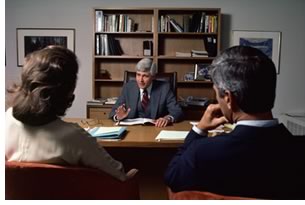

4/2006
Working without a contract

by James B. Atkins, FAIA and Grant A. Simpson, FAIA
Have you ever provided design services without a contract? If your answer is “no,” it is likely that you are somewhat new to the profession of architecture. Most architects have provided professional services without executing a contract at some time in their career. It is gratifying to receive a commission, and we tend to want to get the work going and worry about the contractual stuff later. It does not help that contracts are more complicated these days. Owners and their lawyers often negotiate tough conditions. Getting the contract executed often takes time and requires advice from our insurance agent or our lawyer.
Design services can range from brief studies and evaluations to full basic services. Although common in the industry, it is risky to document services on small projects with letter agreements. It is convenient to keep a template on our hard drive and fill in the blanks, sending it to the client quickly. Abbreviated letter agreements, however, often do not provide sufficient protection against the perils inherent in today’s practice.
 On
larger projects, we have become accustomed to lengthy negotiation periods,
and we tend to go about work without the feeling of urgency that is warranted
in getting a contract executed. Contract negotiation is viewed by many
architects to be an adversarial process that they would like to avoid.
When those monthly checks begin to arrive from the owner, optimism can
take over, and we may disregard getting the final contract executed altogether.
On
larger projects, we have become accustomed to lengthy negotiation periods,
and we tend to go about work without the feeling of urgency that is warranted
in getting a contract executed. Contract negotiation is viewed by many
architects to be an adversarial process that they would like to avoid.
When those monthly checks begin to arrive from the owner, optimism can
take over, and we may disregard getting the final contract executed altogether.
Meanwhile, the risks inherent in architecture practice are greater than they have ever been. A fair and balanced contract is essential if we want to protect ourselves adequately. When we work without a contract, we are like the aerialist high above the ground, walking the high wire with no safety net below. All will be fine as long as everything goes as planned. However, should things go awry, our professional and financial health could be threatened.
This article will explore the dangers of working without a contract and the safeguards that well-executed service agreements can provide. It will address the importance of effective contracts management, including suggestions for setting up a contracts management program in your firm. Included will be suggestions on what to do in difficult situations, such as when clients refuse to sign the contract.
What do contracts do?
Among other things, contracts establish a documented
record of what services we are going to provide for the fee that we
earn. Such documentation is necessary to help avoid disputes in the services
scope and avoid misunderstandings. The following paragraphs address
some important parts of a contract.
Identification of parties. It is important that individuals and companies doing business together be accurately identified in the agreement. Not only is this necessary to make sure that the agreement forms a binding contract between the right parties, but it is also necessary to help avoid potential problems in communications. It is wise for the name of the owner’s designated representative to be listed as the primary contact so as to allow one source of communications.
 Scope of services. Architectural design can encompass many things. There
are basic services that are typically provided for projects; however,
the expectation of the result of those services can vary greatly. The
contract, if properly written, can define services in a way that will
help prevent misunderstanding. When services are adequately defined in
the contract, there is less confusion regarding subsequent “additional
services” for which the architect will expect to be paid.
Scope of services. Architectural design can encompass many things. There
are basic services that are typically provided for projects; however,
the expectation of the result of those services can vary greatly. The
contract, if properly written, can define services in a way that will
help prevent misunderstanding. When services are adequately defined in
the contract, there is less confusion regarding subsequent “additional
services” for which the architect will expect to be paid.
Compensation. The fee basis as well as the sequence and conditions for making payment are typically defined including hourly rates for services later added to the agreement. This should help avoid misunderstandings and simplify payment for additional services beyond basic services.
Termination. Contracts should also provide options and conditions for contract termination, including fair payment for work performed through the termination date. Some owners include terms requiring the architect to surrender ownership and copyrights to drawings and other instruments of service. An appropriately written termination clause can stipulate that ownership transfer will not occur until the architect has received payment for this work. These conditions can decrease the chance of wrongful termination claims and hopefully provide an organized transition.
General Conditions. Another important component of a contract is to establish a uniform set of general conditions of the contract for construction. These conditions set out the duties and responsibilities of the parties during the construction phase and help reduce confusion. AIA Document A201-1997, General Conditions of the Contract for Construction, is the document most commonly used for this purpose.
When the architect negotiates a basic services agreement, A201 is typically referenced as the general conditions document, as in B141-1997, Section 2.6.1.1. However, when the contractor and owner negotiate their contract, they sometimes agree on different general conditions or they modify A201-1997 from its original form. Since the architect’s agreement is usually executed first, the architect should compare the two general conditions (including any supplemental conditions to the construction contract) to determine if the requirements placed on the architect are consistent. It is advisable to explain to the owner the value in maintaining the close interrelationship between A201-1997, if used, and the other AIA documents that may be used on the project. The AIA documents consistently relate to each other, within each document family, and changes in one document can adversely affect others.
 If
you are using B141-1997 or B151-1997, you are contractually obligated
only for the contract conditions in the A201-1997 as originally published
by the AIA, provided that it is the general conditions document referenced,
but you will still need to know if the owner and contractor have modified
it. For example, the owner and contractor may have agreed to specific
general conditions changes in their contract which will lead them to
expect a different level of service than your agreement requires. Some
owners and contractors view their agreements as confidential. Should
the owner or contractor refuse to provide you a copy of the owner-contractor
agreement and general conditions, which is unfortunately a more frequent
occurrence in today’s practice, it will be impossible to know whether
the Owner has modified the contract conditions you are to administer
under your agreement. In this instance, you should attempt to explain
to the owner that your contract requirements must conform to that of
the contractor’s, or one or both of you may not be able to deliver
the contracted services.
If
you are using B141-1997 or B151-1997, you are contractually obligated
only for the contract conditions in the A201-1997 as originally published
by the AIA, provided that it is the general conditions document referenced,
but you will still need to know if the owner and contractor have modified
it. For example, the owner and contractor may have agreed to specific
general conditions changes in their contract which will lead them to
expect a different level of service than your agreement requires. Some
owners and contractors view their agreements as confidential. Should
the owner or contractor refuse to provide you a copy of the owner-contractor
agreement and general conditions, which is unfortunately a more frequent
occurrence in today’s practice, it will be impossible to know whether
the Owner has modified the contract conditions you are to administer
under your agreement. In this instance, you should attempt to explain
to the owner that your contract requirements must conform to that of
the contractor’s, or one or both of you may not be able to deliver
the contracted services.
One option is to send the owner a blank copy of the AIA Owner-Contractor form that pertains to the way the project is contracted. For example, if the project is a lump-sum contract, you would use AIA Document A101-1997, Standard Form of Agreement Between Owner and Contractor where the basis of payment is a STIPULATED SUM. Include with it a copy of A201-1997, General Conditions of the Contract for Construction as referenced in the agreement.
Remind the owner that you have requested a copy of the executed Owner-Contractor Agreement with General Conditions and advise them that unless they indicate otherwise, you are assuming that the enclosed documents represent the way that they expect you to perform services for administration of the contract for construction. These actions often result in a copy of the executed agreement sent by return mail, but, if not, you at least have informed the owner of your contracted scope of services. If this effort fails, you should consult with your lawyer or insurance agent for assistance. If you do nothing, your actions could be called into question because of conflicts with an owner-contractor agreement that conflicts with your service agreement.
 Responsive actions to non-standard contracts
Responsive actions to non-standard contracts
The AIA documents are the
industry standard for how we practice architecture, and when they remain
intact, we can generally go about our work, business as usual. However,
significant changes to the documents by clients are becoming more prevalent.
The result could be an agreement that does not include requirements
and conditions that conform to commonly accepted standards of architecture
practice and that give us reasonable protection. Should this occur,
following are some actions that can be taken to attempt to rectify the
difficult issues.
No architect signature on change order. The general conditions in the owner-contractor agreement have been modified and no longer require the architect’s signature on change orders. In this case, the architect should advise the owner that changes to the contract without the architect’s knowledge or consent could prevent their awareness of the project scope and could prevent them from determining the date or dates of substantial completion or assessing final completion.
Waiver of warranty to architect. The owner was persuaded to waive the contractor’s warranty to the architect guaranteeing work conformance. A201-1997, Section 3.5.1, states:
The Contractor warrants to the Owner and Architect that . . . the Work will conform to the requirements of the Contract Documents.
The architect should advise the owner that deleting this requirement will make it difficult, if not impossible, for the architect to certify payments or certify substantial completion, conditions that are often unacceptable to lenders. The architect relies on the contractor’s warranty that work put in place will be in conformance whether or not the architect is on site and observes the work. The issue of Substantial Completion is covered in detail in the January 2006 article Substantial Completion, Where Art Thou?
Submittals redefined as contract documents. The owner has agreed to a contractor demand that the owner-contractor agreement define submittals to be contract documents. For good reason, A201-1997, Section 3.12.4, states that shop drawings and submittals are not contract documents. The architect should explain to the owner that if the contractor’s submittals are defined as contract documents, the contractor can change the contract scope and thus manipulate the value of the project.
Clearly, it is a disadvantage to the owner to allow contract requirements to be altered by the contractor’s submittals. If the owner agrees to have submittals defined as contract documents, the architect could add an explanatory note to each submittal explaining that they have been prepared by the contractor who is solely responsible for their content, and the architect’s review action makes no representations as to their accuracy or completeness.
Steadying the high wire
Such changes in the contract are usually made because the owner does
not understand the issues, and dialogue with the owner often helps.
However, if the owner refuses to address discrepancies between the
agreement with the contractor and the agreement with the architect,
the architect should consider advising the owner in writing as to how
its services will be impacted.
 Hopefully, this notice will cause a desire to coordinate the construction
contract with the owner-architect agreement, including the applicable
general conditions. If not, the architect must decide if the added risk
is worth the agreed upon professional fee. The most effective way to
manage these issues is to resolve them during negotiation of the owner-architect
agreement.
Hopefully, this notice will cause a desire to coordinate the construction
contract with the owner-architect agreement, including the applicable
general conditions. If not, the architect must decide if the added risk
is worth the agreed upon professional fee. The most effective way to
manage these issues is to resolve them during negotiation of the owner-architect
agreement.
Your contracts management program
Ideally all professional
services should be performed under a written contract. It can be helpful
to develop a contracts management program to increase the chances that
some form of contract is executed on all projects. A contracts management
program can be beneficial to the sole practitioner as much as to the
larger firm. One could be developed along the following lines:
Standard Owner-Architect Agreements. Develop a standard marked-up agreement for each type of services you perform. This can range from a letter agreement to a full service contract depending upon the services to be provided. Letter agreements, although not recommended by the AIA, are widely used. When applicable, as in the case of a full service Owner-Architect agreement, choose an AIA form of agreement that best suits your needs, and modify it to meet the needs of your practice. If you think it necessary to modify agreement terms, consult your lawyer and your professional liability insurance agent for assistance. The agent should have access to resources such as insurance company in-house lawyers and panel counsel who may be able to provide assistance in developing the specific contract wording. Your standard mark-up may not survive negotiations completely intact, but at least you will have established a contractual position for the initiation of discussions.
Atypical conditions. Another key element of your contracts management program can be to develop a process for determining “atypical contract conditions” and communicating them to your project team. When an agreement is negotiated with an owner, there are often some conditions that vary from standard AIA language. Conditions that vary from the AIA language should be highlighted and communicated to the team.
For example, in the AIA’s B141-1997 document, the frequency and number of architect’s site visits is left for the architect to negotiate with the owner. Should you negotiate a contract that stipulates, “The architect will visit the project fifty times during construction at intervals not to exceed one time per week,” the project team must be made aware of this strict requirement so that someone can substitute for the construction administrator when that person is ill or on vacation. Do not forget that, in this instance, site visits requested in excess of the stipulated number can be billed as an additional service to your contract.
 For
more information about dealing with difficult contract requirements such
as these, refer to our June 2005 article, Another
Fine Mess: The Onerous Contract. [Part
I and Part
II]
These articles and more are available for AIA members on
the Risk Management Resource Center Web site.
For
more information about dealing with difficult contract requirements such
as these, refer to our June 2005 article, Another
Fine Mess: The Onerous Contract. [Part
I and Part
II]
These articles and more are available for AIA members on
the Risk Management Resource Center Web site.
Outside reviews. Another important aspect of your program should be structured reviews of unfamiliar or difficult contract clauses by a competent outside source. Experienced construction lawyers can be retained for this purpose or your professional liability insurance company may provide this service as a part of your policy support. If paying a fee for this service concerns you, remember that the money spent to avoid a claim is frequently a fraction of the amount required to defend against one.
 Contracts management policies. In a larger firm, it is a good idea to
establish policies for maintaining consistency and managing risk. The
following suggestions may be useful in developing your contracts management
policies:
Contracts management policies. In a larger firm, it is a good idea to
establish policies for maintaining consistency and managing risk. The
following suggestions may be useful in developing your contracts management
policies:
- Letter agreements—If your firm uses letter agreements, develop a consistent format and determine to what extent professional services will be performed with this approach. Require your associates to convert the letter agreement to a formal Owner-Architect agreement should the project proceed beyond some pre-established preliminary phase.
- Deal breakers—Consult with your insurance agent or legal counsel to identify contract clauses and conditions with risks that exceed available rewards. You may also wish to have your agent or lawyer assist you in explaining these issues to a client when they arise. Be alert for new deal breakers when negotiating and check with your agent or lawyer when in doubt. Some firms include potential deal breaker clauses as a part of their “Go–No Go” decision making process.
- Outside contract reviews—Establish a policy for when a proposed agreement should be reviewed by an outside source. Lawyer- generated and extensively marked-up AIA documents often deserve scrutiny. Unusual certifications that go beyond those addressed by AIA documents should definitely be targeted.
- Consultant agreements—It is important to establish a protocol for executing your Architect-Consultant agreements after the Owner-Architect agreement is signed. Some practitioners believe it is acceptable to work with consultants with only a letter agreement. However, the requirements in the Owner-Architect agreement must be passed through to the consultant for the architect to have adequate contractual protection. AIA Document C141-1997, Standard Form of Agreement Between Architect and Consultant, tracks the AIA owner-architect agreements and is available for this purpose.
- Additional services—It is important to establish the method by which you will contract for additional services. There are options available in the AIA family of documents, including AIA Document G606-2000, Amendment to the Professional Services Agreement, which can be used to modify an existing Owner-Architect agreement.
Execution of the agreement
Agreements are not finalized until the terms and conditions are agreed
upon by both parties in writing. Absent a signed agreement, the contract
may be disputed.
There may be occasions when contract negotiation is held up by the owner. For instance, suppose you have traded drafts and made your revisions, and the Owner-Architect Agreement is in the owner’s possession. Weeks and months have passed, and there is no return draft. Your queries to the owner remain unanswered. It appears that the owner does not intend to finalize the agreement.
 Although
the most recent draft agreement exchanged between the parties may support
credibility, it could just as likely serve to show that the parties did
not agree on its provisions. Other actions can be taken to assist in
confirming the owner’s acceptance. Communicate with the
owner by a traceable means such as certified letter or e-mail advising
that you are providing services according to your last draft agreement
unless they advise you to the contrary. While this may not show the owner’s
acceptance of the contract to the degree a signature would, it is nonetheless
better than taking no action and hoping for the best.
Although
the most recent draft agreement exchanged between the parties may support
credibility, it could just as likely serve to show that the parties did
not agree on its provisions. Other actions can be taken to assist in
confirming the owner’s acceptance. Communicate with the
owner by a traceable means such as certified letter or e-mail advising
that you are providing services according to your last draft agreement
unless they advise you to the contrary. While this may not show the owner’s
acceptance of the contract to the degree a signature would, it is nonetheless
better than taking no action and hoping for the best.
Again, many architects view contract negotiations and getting contracts signed as inherently adversarial activities. You should view these activities as due diligence aimed at positioning your project for success.
Additional services
Another area where owners are often reluctant to sign agreements is additional
services. Agreements often require the owner’s written acceptance
in advance, but with the time-driven activities inherent in design
and construction, it is often difficult to get a signed approval before
you do the work.
A helpful recourse can be to send a confirming communication advising that you are assuming that the owner agrees unless notice to the contrary is received within a given period. You should confirm that the additional services are appropriate and have been requested before taking this action.
For more information on our views about the types and adequacy of documentation refer to our April 2005 article, “To Document or Not to Document.”
Initiating your contracts management program
Adequately enforcing these policies and procedures in your firm will
require monitoring and management. It can be helpful to create a Contracts
Management File to help bring order to the process. The file should
contain copies of all signed agreements, the complete history of any
unsigned agreements, transmittal records if no agreement has been signed,
and logs indicating the status of additional service agreements and
consultant agreements.
 If the file is initiated at the onset of the project, it can be a helpful
management tool throughout the phases of service. If your project management
should transition from one person or department to another, the file
can assist in maintaining continuity on the project and communicating
important contract status information. It can also serve as a way to
communicate with your bookkeeper or accountant to facilitate effective
invoicing.
If the file is initiated at the onset of the project, it can be a helpful
management tool throughout the phases of service. If your project management
should transition from one person or department to another, the file
can assist in maintaining continuity on the project and communicating
important contract status information. It can also serve as a way to
communicate with your bookkeeper or accountant to facilitate effective
invoicing.
The safety net
The negotiation and execution of contracts has become more difficult
over the years. The number of non-standard or lawyer-generated agreements
could likely increase. It is also likely that the complexity and the
physical size of the average contract may increase. Even if the Building
Information Model brings us a more integrated, less litigious process,
if we wish to maintain a reasonable balance of risk and reward, we
must manage our contract negotiation and execution as efficiently as
possible. Effective contracts management is as important as providing
effective design services because risks must be managed and fees must
be collected if we expect to achieve success.
 When you sit down at the negotiation table and check your list of deal
breakers, bear in mind that the draft agreement in front of you will
become your safety net. The effectiveness of that net will be determined
by the effectiveness of your actions and decisions in negotiating the
agreement and its conditions. Be mindful that when agreement is reached,
and you begin your services, should you encounter problems and slip from
the high wire; a fair and balanced agreement can help stop your free
fall.
When you sit down at the negotiation table and check your list of deal
breakers, bear in mind that the draft agreement in front of you will
become your safety net. The effectiveness of that net will be determined
by the effectiveness of your actions and decisions in negotiating the
agreement and its conditions. Be mindful that when agreement is reached,
and you begin your services, should you encounter problems and slip from
the high wire; a fair and balanced agreement can help stop your free
fall.
As you ponder putting off until tomorrow calling your client about the status of the contract, and as you teeter and sway on the high wire, don’t look down, and always, remember to be careful out there.
Copyright 2006 The American Institute of Architects.
All rights reserved. Home Page ![]()
![]()
This series will continue next month in AIArchitect when the subject will be “According to Hoyle, The Submittal Process.” Learn how to manage the submittal review process and respond to the challenges in today’s market. If you would like to ask Jim and Grant a risk- or project-management question or request them to address a particular topic, contact them through AIArchitect.
James B. Atkins, FAIA, is a principal with HKS Architects. He serves on the AIA Documents Committee and is the 2006 Chair of the AIA Risk Management Committee.
Grant A. Simpson, FAIA, manages project delivery for RTKL Associates. He is the 2006 Chair of the AIA Practice Management Advisory Group.
This article represents the opinions of the authors and not necessarily that of The American Institute of Architects. It is intended for general information purposes only and does not constitute legal advice. The reader should consult with legal counsel to determine how laws, suggestions, and illustrations apply to specific situations.
![]()